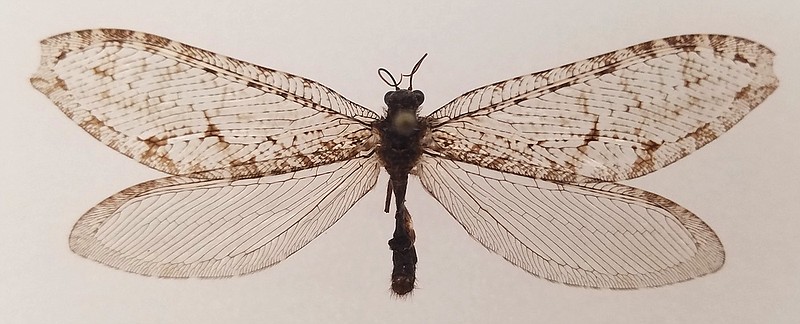A large, winged insect was plucked from the facade of a Walmart Neighborhood Market in east Fayetteville in 2012.
Michael Skvarla, a graduate student in entomology at the University of Arkansas, said he didn't know what he had at the time.
He went about his shopping with the bug between his fingers. He took it home, mounted it and forgot about it for almost a decade.
Skvarla said he thought the insect was an antlion, but he was wrong.
In 2020, while teaching a class via Zoom, Skvarla realized the insect from his private collection that the class was studying was a Polystoechotes punctata, also known as a giant lacewing.
It was the first giant lacewing recorded in eastern North America in over 50 years -- and the first record of the species ever in Arkansas, Skvarla and J. Ray Fisher wrote in a recent paper for the Proceedings of the Entomological Society of Washington.
"Giant lacewings are still extant in western North America in the Rockies and West Coast of the U.S. and Canada," Skvarla said in an email. "I'm not sure they're ever particularly common or abundant, but you can still find them there."
After receiving masters and doctoral degrees in entomology from the university in Fayetteville, Skvarla is now director of Pennsylvania State University's Insect Identification Lab.
Penn State sent out a news release about the journal article on Monday.
Fisher lives in Rogers and also got his Ph.D. in entomology from the University of Arkansas in Fayetteville. He's a research entomologist for Mississippi State University who works remotely from the UA campus in Fayetteville.
Fisher said the reference in the news release to the giant lacewing as a "Jurassic-era insect" is a bit of a stretch. He said it's one of about 60 species with an evolutionary lineage that can be traced back to a common ancestor that originated in the Jurassic.
And "giant" is only in relation to other lacewings, which are smaller, he said. The specimen Skvarla found has a wingspan of about about 50 millimeters.
Ashley Dowling, a UA professor who served as Skvarla's major adviser, said some media outlets had blown things out of proportion by going with "Jurassic insect" headlines.
That made it sound like "some prehistoric giant insect" had been found at a Fayetteville Walmart, he said in an email.
"In reality, these giant lacewings are common out west and this species used to be more common across the U.S.," wrote Dowling. "I don't think we're going to find folks camping out at Walmart this summer hunting for this insect, but I think some local naturalists will pay a little closer attention to any large lacewing-looking bugs they see."
The find brings up the question of whether there is a relic population of giant lacewings in the Arkansas Ozarks.
But the bug could have been a hitchhiker, said Fisher.
"Most likely this specimen hitched a ride on someone's truck or something when they came from out west," said Fisher. "And it flies to a light at Walmart from the truck."
Fisher said he has no official opinion on whether Skvarla's sample was a local lacewing or imported.
"I lack an opinion because it's such a curious, fun question," he said.
Fisher said efforts were made to take DNA samples from the insect to determine if it was closely, or more distantly, related to the giant lacewings out west. But the specimen was too old, so the effort was unsuccessful, he said.
"There's only one way we're going determine it, and that's with more specimens," said Fisher.
He said insect identification social media websites like inaturalist.org and bugguide.net have made it easier to track the existence of insects across the country.
Giant lacewings were historically widespread across most of North America, but are now thought to be extirpated from eastern North America, with the last specimens collected in the 1950s, Skvarla and Fisher wrote in their paper.
"Although the absence of P. punctata records could be due to a lack of collection effort or collected specimens being ignored or misidentified, it seems likely that they really are absent from much of their former range given their large size (50 mm wingspan), attraction to lights, and often considerable collecting effort and expertise concentrated around entomology teaching institutions and biodiversity hotspots such as the All Taxa Biodiversity Inventory in the Great Smokey Mountains," they wrote. "For example, the last specimen collected in Ithaca, New York around Cornell University was in 1890 and it seems unlikely that such a large, interesting insect would go unnoticed by generations of entomologists if it was still present in the area."
There are no historic records of giant lacewings in Arkansas, including unidentified or unpublished specimens in the University of Arkansas Arthropod Museum, so the new specimen is the first record for the state, according to the paper.
"It is also the first record of P. punctata east of the 100th west meridian since 1951 (Owosso, MI) and first in the Southeast since 1929 (Blood Mountain, GA)," they wrote.
"The Ozark Mountains, and the Interior Highlands more generally, are a suspected biodiversity hotspot," according to Skvarla and Fisher. "Dozens of endemic species, including 68 species of insects, are known from Ozarks, and at least 58 species of plants and animals have highly disjunct populations with representatives in the region. However, it is understudied compared to regions of similar biodiversity, such as the Southern Appalachians. This combination makes the region an ideal place for a large, showy insect to hide undetected."
